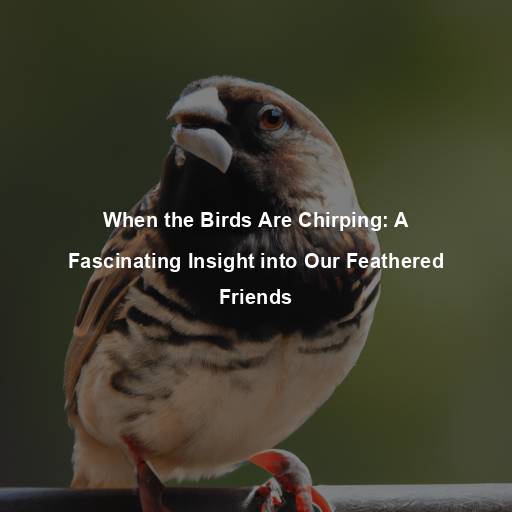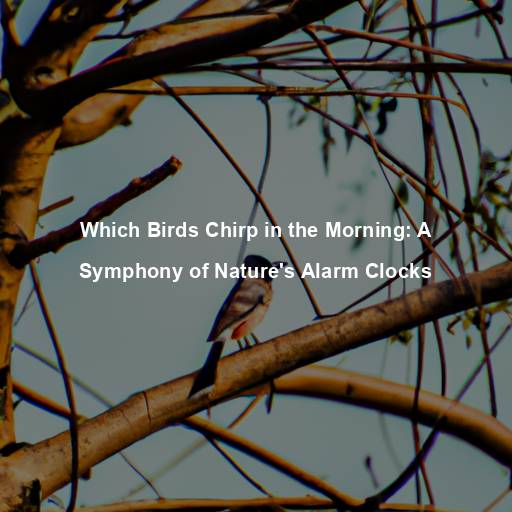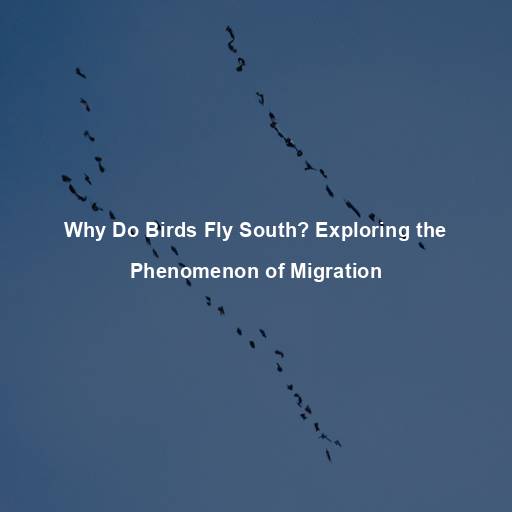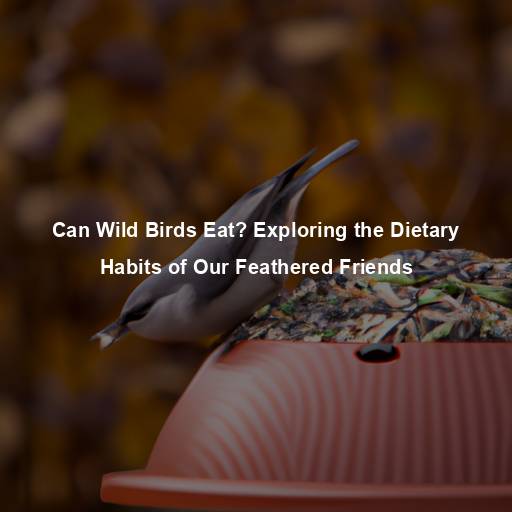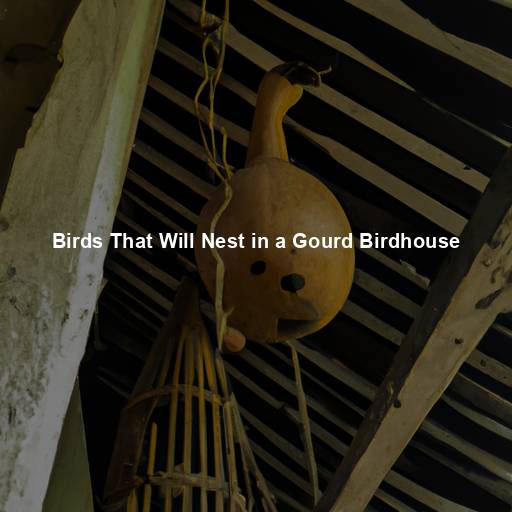When the Birds Are Chirping: A Fascinating Insight into Our Feathered Friends
Last Updated on August 5, 2023 by Evan
Birds, with their enchanting songs and graceful flight, have captivated the hearts and imaginations of humans for centuries. From the vibrant plumage of tropical parrots to the melodious tunes of songbirds, these creatures have a unique place in our world. In this in-depth exploration, we will delve into the intriguing world of birds, their behaviors, their habitats, and the remarkable relationship they share with humans. Join us on this journey as we uncover the wonders of our avian companions and gain a deeper understanding of their significance in our lives.
Contents
- 1 The Symphony of Chirps: Understanding Birdsong
- 2 The Therapeutic Presence of Birds
- 3 Conservation: Protecting Our Avian Friends
- 4 The Enduring Fascination: Birds in Art, Literature, and Culture
- 5 A Deeper Connection: Our Shared Existence
- 6 The Enigmatic World of Bird Migration
- 7 The Fascinating Adaptations of Birds
- 8 The Intricate Interactions between Birds and Humans
- 9 FAQs for when the birds are chirping
The Symphony of Chirps: Understanding Birdsong
Birdsong is a universal language, transcending geographical boundaries and cultural differences. The melodious chirping of birds serves multiple purposes, ranging from attracting mates to defending territories and communicating with their flock. Each species has its distinctive repertoire of calls and songs, creating a symphony of natural music that harmonizes with the environment.
The Language of Love: Bird Courtship
Courtship rituals in birds are a sight to behold, showcasing elaborate displays of affection and devotion. Male birds use their vocal talents and vibrant plumage to woo potential mates, engaging in intricate dances and acrobatic aerial displays. From the mesmerizing courtship flights of birds of paradise to the intricate nest-building rituals of weaver birds, these displays not only ensure the survival of the species but also provide us with a glimpse into the beauty of nature’s love stories.
Winged Architects: The Art of Nest Building
When it comes to building homes, birds are the true MVPs. These little architects work tirelessly to create cozy havens for their precious eggs and chirping chicks. The sheer variety in their nest designs is mind-boggling, from the intricate weavings of songbirds to the lofty platforms of birds of prey. Observing their construction skills is a humbling experience, reminding us of their incredible ingenuity and ability to adapt to their surroundings.
Migration: Epic Journeys Across Boundless Skies
Migration is a phenomenon that has fascinated scientists and bird enthusiasts alike. Each year, millions of birds embark on incredible journeys, traversing vast distances in search of favorable breeding grounds and food sources. From the Arctic tern, which migrates from the Arctic to the Antarctic and back, to the majestic raptors soaring over continents, migration showcases the indomitable spirit and resilience of these winged travelers.
The Therapeutic Presence of Birds
Birds, with their charming appearance and fascinating antics, possess a remarkable ability to influence our overall state of being. Their mere presence can have a profound effect on our mental and emotional equilibrium, serving as a source of solace and comfort during moments of solitude and turmoil. The therapeutic benefits of these winged wonders extend far beyond their visual appeal, leaving us captivated and bewildered by their enchanting influence on our well-being. Join us as we embark on a journey to unravel the mysteries and blessings that birds bestow upon our lives.
Birdwatching: A Window to Serenity
Birdwatching, also known as birding, is a popular recreational activity that allows individuals to connect with nature and find solace in its tranquility. The act of observing birds in their natural habitats can be a meditative experience, fostering a sense of mindfulness and serenity. As we immerse ourselves in the sights and sounds of the avian world, we find respite from the chaos of everyday life and gain a renewed appreciation for the beauty of our natural surroundings.
Avian Companions: The Joy of Pet Birds
For centuries, our homes have been graced with the delightful presence of pet birds, their vibrant feathers and contagious energy sparking joy and creating an ambiance of warmth and affection. From the carefree flutterings of parakeets to the captivating conversations of African grey parrots, these captivating creatures have woven their way into the very fabric of our lives. With their ability to alleviate stress, infuse our days with purpose, and forge unbreakable bonds, these winged companions truly exemplify the essence of companionship and love within our households.
Birdsong Therapy: Healing Through Harmonies
Discover the ancient healing power of birdsong that has resonated through the ages, captivating our souls with its mesmerizing melodies. Experience the transformative effects as scientific research unveils the profound impact that these musical creatures have on our emotional well-being. From calming our racing minds to soothing our troubled hearts, the symphony of chirping birds offer us a sanctuary of peace, a refuge from the chaos of daily life. Immerse yourself in nature’s therapeutic embrace and unlock the hidden secrets of serenity through the subtle yet powerful language of birdsong.
Conservation: Protecting Our Avian Friends
While birds bring us immense joy and wonder, they also face numerous threats in the modern world. Habitat loss, climate change, and pollution are just a few of the challenges that jeopardize the survival of many bird species. Conservation efforts play a crucial role in safeguarding these magnificent creatures and preserving their habitats for future generations.
Protecting Habitats: Preserving Biodiversity
Preserving natural habitats is essential for the survival of bird populations. By conserving forests, wetlands, and grasslands, we provide birds with the resources they need to thrive. Efforts to protect these habitats involve creating protected areas, implementing sustainable land management practices, and raising awareness about the importance of biodiversity conservation.
Preventing Bird Collisions: A Window to Safety
Every year, countless birds meet tragic fates as they collide with glass windows, leaving us all perplexed by the magnitude of these avian casualties. Fortunately, there are solutions to this disheartening problem that will leave our feathered friends unscathed. From utilizing bird-friendly glass that acts as a guiding light for our airborne companions, to adorning our windowpanes with adorable decals that serve as a visual warning, we can embrace these small yet impactful actions to create a safer world for our avian allies. So, let us embark on a quest to protect and nurture these delicate creatures by transforming our homes and buildings into bird-friendly havens, for the sake of our shared living planet.
Advocacy and Education: Empowering Change
The realm of bird conservation is a perplexing world, where advocacy and education collide in a burst of fervor. It is through these avenues that we unravel the intricate tapestry of bird preservation, delicately weaving strands of awareness and inspiration. With every flutter of knowledge, the intricate wings of bird conservation gain strength, empowering individuals to embark on a quest to make a transformative impact. Together, we can champion citizen science initiatives, support local birding organizations, and immerse ourselves in the restoration and preservation of their precious habitats.
The Enduring Fascination: Birds in Art, Literature, and Culture
Birds have woven themselves into the tapestry of human history, stirring the hearts and minds of artists, writers, and musicians alike with their enigmatic charm. From time immemorial, these remarkable creatures have sparked inspiration, leading to the creation of masterpieces that exalt their fascinating allure. Throughout various artistic mediums, birds have become emblems of liberty, spirituality, and metamorphosis, leaving an indelible mark on our collective consciousness and nurturing the growth of our cultural legacy.
Birds in Mythology: Symbols of Divinity
Throughout the annals of time, various mythologies have woven intricate tales, interwoven with the enigmatic presence of birds. From the grandeur of Zeus, whose sovereignty was embodied by the majestic eagle, to the phoenix, a resplendent symbol of ancient Egyptian mysticism and eternal rebirth, these ethereal creatures have captivated the human psyche. Their ethereal significance, evoking notions of wisdom, transcendence, and renewal, lends credence to the undeniable allure that birds have exerted upon our collective consciousness.
Birds in Art: Capturing the Essence of Flight
Artists have long been inspired by the beauty and grace of birds, capturing their essence through various mediums. Paintings, sculptures, and intricate woodcarvings have immortalized the intricate details of feathers, the elegance of flight, and the vibrant colors of avian plumage. From the iconic works of John James Audubon to the delicate brushstrokes of Chinese bird-and-flower paintings, avian art continues to awe and inspire.
Birds in Literature: Metaphors and Symbolism
Birds have served as powerful metaphors and symbols in literature, representing a range of emotions, ideas, and themes. From the caged bird in Maya Angelou’s poem “I Know Why the Caged Bird Sings” to the raven in Edgar Allan Poe’s haunting poem “The Raven,” birds have been used to explore concepts of freedom, captivity, and the human condition. Their inclusion in literary works adds depth and richness to the narratives, inviting readers to ponder the complexities of life through avian perspectives.
In the intricate tapestry of life, birds hold a special place, bridging the gap between the natural world and human society. Their songs, their behaviors, and their vibrant presence remind us of the interconnectedness of all living beings. As we listen to the birds chirping, let us embrace the marvels of the avian world and cherish the profound bond we share with these remarkable creatures.
In a mesmerizing voyage through the realm of feathery wonders, we find ourselves captivated by the exquisite grace and enigmatic allure of our avian comrades. From the delicate symphonies reverberating through ethereal branches to the awe-inspiring spectacle of their majestic journeys across distant horizons, birds truly bestow upon us a boundless tapestry of awe. As we embark on this enduring quest to cherish, safeguard, and revel in the extraordinary existence of these mesmerizing creatures, we foster a harmonious union between our species and feathered ambassadors, ensuring an intricate dance of cohabitation for generations yet to unfold.
A Flourishing Hobby: Exploring the Avian Realm
Birdwatching, also known as birding, has gained immense popularity as a recreational activity worldwide. It offers enthusiasts the opportunity to observe and study birds in their natural habitats, fostering a deep connection with nature. Armed with binoculars, bird field guides, and a sense of curiosity, birdwatchers embark on quests to spot rare species, document behaviors, and contribute to scientific research.
Hotspots of Biodiversity: Prime Birding Locations
Certain regions of the world are renowned for their rich avifauna and are considered prime birding locations. From the lush rainforests of the Amazon to the vast wetlands of the Okavango Delta, these hotspots attract birdwatchers from across the globe. These areas provide a diverse range of habitats, offering a home to a multitude of bird species, making them ideal for birding adventures.
Citizen Science: Birdwatchers as Data Collectors
In the vast expanse of nature, there exists a symphony of fluttering wings and melodious chirps, captivating the hearts of those who dare to pause and listen. Among these enchanted souls are birdwatchers – humble observers who, armed with binoculars and boundless curiosity, embark on a quest to unravel the enigmatic world of avifauna. Little do they realize that in their pursuit of feathers and flight, they are destined to become more than just spectators. Indeed, these unwitting heroes, known as citizen scientists, hold within their hands a power beyond measure – the power to contribute to the advancement of scientific research and conservation efforts through their meticulous observations and steadfast dedication.
The Enigmatic World of Bird Migration
Wings Across Continents: The Phenomenon of Migration
Migration is one of the most awe-inspiring aspects of bird behavior, as countless species undertake remarkable journeys across vast distances. Birds migrate in search of favorable breeding grounds, abundant food sources, or to escape harsh environmental conditions. Their ability to navigate over long distances using celestial cues, landmarks, and Earth’s magnetic field is a testament to their remarkable instincts and adaptability.
The precise mechanisms by which birds navigate during migration remain a subject of scientific inquiry. While researchers have identified several cues that birds may use, such as the position of the sun, stars, and Earth’s magnetic field, the exact mechanisms are complex and not fully understood. Additionally, some species rely on visual landmarks and geographical features to navigate, while others may possess an innate map-like sense.
Perils of the Journey: Challenges Faced by Migratory Birds
The incredible journeys of migratory birds are riddled with a myriad of obstacles and trials. These winged wonders face a constant battle against the loss of crucial stopover habitats and the unpredictable disruption of resources caused by the ever-looming menace of climate change. As if that wasn’t enough, the towering menace of human-made barriers, such as skyscrapers and communication towers, adds an additional layer of perplexity to their already challenging voyage. Thankfully, conservation endeavors are striving to combat these threats head-on, working tirelessly to safeguard the precious stopover sites that are vital for the survival of these magnificent migrators.
The Fascinating Adaptations of Birds
Beaks and Bills: Evolutionary Marvels
Birds exhibit an incredible diversity of beak shapes and sizes, each adapted to suit their specific feeding habits. From the long, slender bills of hummingbirds for sipping nectar to the sharp, curved beaks of raptors for tearing flesh, these adaptations allow birds to exploit various food sources and occupy unique ecological niches. The evolution of beaks showcases the remarkable adaptability and resourcefulness of avian species.
Feathers: More Than Meets the Eye
Feathers are one of the defining features of birds, serving multiple functions beyond flight. They provide insulation, aid in courtship displays, and play a crucial role in species recognition. The vibrant colors and intricate patterns of feathers have captivated human imagination and have been a source of inspiration for art and fashion. Additionally, feathers are also used by birds as a means of communication and camouflage, allowing them to thrive in diverse habitats.
Avian Intelligence: The Clever Capabilities of Birds
Contrary to popular belief, birds possess remarkable cognitive abilities and display complex behaviors. Some species have demonstrated problem-solving skills, tool use, and even self-recognition in mirrors. Birds like crows and parrots are renowned for their intelligence and have the capacity for learning and mimicry, showcasing their adaptability and capacity for innovation.
The Intricate Interactions between Birds and Humans
Birds as Pollinators: Nature’s Gardeners
Birds are the unsung heroes of the plant world, secretly moonlighting as pollinators and ensuring the survival of countless species. From the enchanting hummingbirds to the dainty sunbirds and the hardworking honeyeaters, these feathered creatures embark on a mission to transfer pollen while indulging in the sweet nectar. This delicate dance between birds and flowers illuminates the perplexing complexity of our interconnected ecosystems, underscoring the irreplaceable role of birds in preserving the rich tapestry of life on our planet.
Birds and Agriculture: Friends or Foes?
While birds provide invaluable services in natural ecosystems, they can sometimes come into conflict with human activities, particularly in agricultural settings. Some bird species, such as sparrows and blackbirds, may damage crops, leading to economic losses for farmers. Balancing the needs of agricultural production with the conservation of bird populations requires innovative approaches, such as implementing bird-friendly farming practices and creating designated habitats to minimize conflicts.
Birds as Indicators of Environmental Health
Birds serve as excellent indicators of environmental health, as changes in their populations and behaviors can reflect broader ecological shifts. Declines in bird populations can signal habitat degradation, pollution, or the impacts of climate change. By monitoring bird populations and studying their responses to environmental changes, scientists gain valuable insights into the overall health of ecosystems and can take proactive conservation measures.
FAQs for when the birds are chirping
When do birds typically start chirping in the morning?
Birds usually begin chirping at the first light of dawn, which is just before the sun rises. The exact time may vary depending on the season and geographical location. In general, you can expect to hear birds chirping about half an hour before sunrise. This early morning chorus is a beautiful sign that a new day is beginning.
Why do birds chirp during sunrise?
Birds chirp in the morning during sunrise for several reasons. One main reason is to establish their territory and communicate with other birds. Male birds often use their songs to attract mates and defend their breeding territories. Chirping during this time is also an effective way to announce their presence and warn off potential competitors. Additionally, singing at sunrise is advantageous as the air is usually calmer, allowing their songs to carry further.
Do birds only chirp in the morning?
Birds are not limited to chirping only in the morning, they can burst into song throughout the day, filling the air with their melodic calls. The dawn chorus may capture our attention, but these feathered creatures are not afraid to perplex us with their sporadic vocalizations at any given moment. From social interactions to courtship exhibitions, and even as a response to potential danger, their chirping serves multifaceted purposes. However, it is important to acknowledge that the level and frequency of their melodic bursts may be influenced by the species of bird and the ever-changing environmental conditions.
Are there certain seasons when birds chirp more?
Yes, certain seasons can influence the frequency and intensity of bird chirping. Spring and early summer are typically when birds are most vocally active. During this time, many bird species are breeding and establishing territories, which leads to increased vocalization. The warmer and longer days of these seasons also provide more opportunities for birds to communicate and attract mates. However, it’s important to remember that not all bird species follow the same vocal patterns, so their behavior can vary.
Why do birds stop chirping at night?
Birds generally cease chirping as daylight fades and night approaches. This is because most birds are diurnal, meaning they are active during the daytime. As darkness falls, they will seek out roosting spots to rest and conserve energy for the next day. Additionally, midnight to early morning hours are often when predatory animals are most active, so being silent and hidden during this time helps birds avoid being detected and becoming a target.
Can the chirping of birds indicate something besides their presence?
The delicate symphony of bird chirping holds more secrets than meets the ears. It’s not just about the presence of these feathered creatures; it’s an intricate language of survival and adaptation. Picture this: a sudden burst of rapid chirping echoing through the trees. It’s not just a random melody; it’s a distress signal, a warning of danger lurking nearby. Moreover, the ever-changing patterns and intensity of their songs can hint at the whims of nature itself. A shift in the tempo could be a sign of an impending storm, and alterations in atmospheric pressure can even influence their vocalizations. In essence, deciphering the nuanced realm of bird chirping can unlock a world of understanding about their behavior and the very environment they inhabit.

